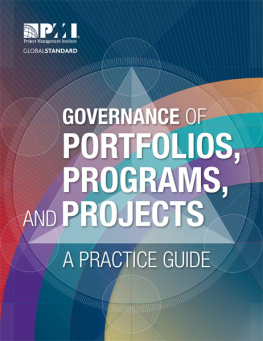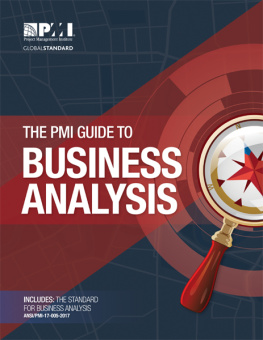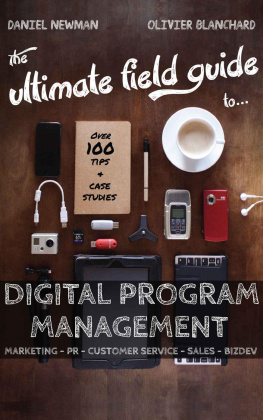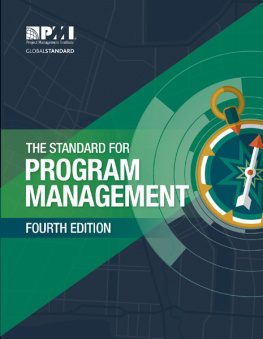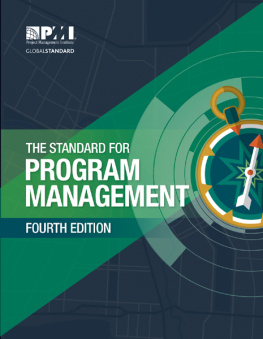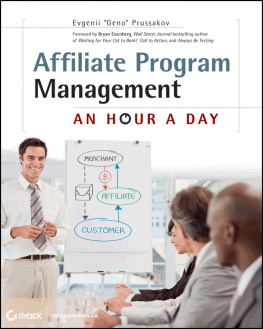Program Management
Contents
Cover
Half Title
Title
Copyright
Contents
List of Figures
List of Tables
Preface
Acknowledgements
Introduction
Executive Summary
PART I THE PROGRAM CONTEXT
1 Background and Definitions
1.1 The Emergence of Program Management
1.2 Visions of Program
1.3 The Issue of Uncertainty and Ambiguity
1.4 Comparison of Leading PgM Standards
1.5 From Program to Organization
2 Organizational Context
2.1 Projects, Programs and Portfolios
2.2 Project-Based Organizations
2.3 Program Offices
2.4 From Managing Programs to Program Maturity
3 Program Context
3.1 Program Culture
3.2 Program Maturity
3.3 Practical Advice to Support Maturity Increase and Culture Shift
3.4 From Program Maturity to Mastery
PART II THE PROGRAM CONSTITUENTS
4 Key Program Functions
4.1 Program Functions in Standards and Guides
4.2 Decision Management
4.3 Program Governance
4.4 Stakeholder Engagement
4.5 Change Management
4.6 Benefits Management
4.7 From Program Mastery to Function Mastery
5 Program Actors
5.1 Roles and Responsibilities
5.2 Leadership and Competencies
5.3 From Program Understanding to Doing
PART III THE PROGRAM LIFE CYCLE
6 Program Life Cycle Outline
6.1 Comparison of Program Life Cycles
6.2 An Agile Program Life Cycle
6.3 From Life Cycle to Management of the Cycle
7 Program Definition (Formulation)
7.1 Define Value Proposition
7.2 Program Formulation
8 Program Definition (Preparation)
8.1 Set-up Program Structure
8.2 Select Program Components for Cycle
8.3 Prepare Definitive Business Case (Benefits Realization Plan)
8.4 Authorize Next Cycle of Program Deployment
8.5 From the Decision to Its Implementation
9 Program Deployment (Capabilities Delivery and Transition)
9.1 Capabilities Delivery (Components Management)
9.2 Capabilities Transition
10 Program Deployment (Capabilities Integration and Benefits Appraisal)
10.1 Capabilities Integration
10.2 Benefits Appraisal
10.3 Transition to Next Cycle
11 Program Closure
11.1 Value Realization Assessment
11.2 Manage Program Completion
11.3 Lessons Learned Finalization
11.4 Closing the Loop and Preparing the Next Challenge
Conclusion
References
Index
List of Figures
1.1 The program and its elements
1.2 The ambiguity-uncertainty context
1.3 Current program management context
2.1 Vertical and horizontal integration of strategies
2.2 Realizing business value
2.3 Traditional compartmentalized project organization
2.4 Value chain project organization
2.5 Agility in project organizations
3.1 Deliberate vs ad hoc programs
3.2 The program value chain
3.3 Maturity development process
4.1 The decision management cycle
4.2 The decision implementation process
4.3 Traditional control-based program governance structure
4.4 Integrated program governance structure
4.5 Integrated program governance structure
4.6 Tiered business case and governance process
4.7 Stakeholder engagement loop
4.8 Example of stakeholder map including contribution and expectations
4.9 Main program stakeholders
4.10 Area of change covered by program management
4.11 Benefits map/benefits breakdown structure concept
5.1 Leadership skills vs role
6.1 The program life cycle
6.2 Taxonomy of program life cycle
7.1 Programme definition flowchart
7.2 Stakeholder mapping techniques
7.3 The value concept
7.4 Example of benefits breakdown structure (BBS)
7.5 Example of paired comparison
7.6a Example strategic roadmap
7.6b Example strategic roadmap
7.7 Evolution of value through life cycle
7.8 Assess alignment (contribution to CSFs)
7.9 Assess achievability (outline level)
7.10 Combined alignment/achievability assessment
7.11 Two options for use of alignment/achievability matrix
8.1 RACI matrix based on accountability for CSFs
8.2 Example of alignment scoring with weighted matrix
8.3 Example of project achievability assessment
8.4 Example of partial blueprint based on BBS
8.5 Pacing the change
8.6 Pacing for ultimate achievement of benefits
8.7 Program strategic roadmap
8.8 Program detailed cycle roadmap
8.9 Example of program level qualitative risk analysis
8.10 Program change decision loops
9.1 Program deployment stage flowchart
9.2 Resource loading plan
9.3 Risk responses and risk packages
9.4 Graphical representation of buffer penetration
10.1 Deployment Level Benefits Register
10.2 Typical responses to deviation
11.1 Program closure flowchart
List of Tables
1.1 Classification of programs and projects: Legend
2.1 Detailed comparison between projects, programs and portfolios
3.1 Comparison of project and program knowledge areas
3.2 Distinction between program and project
5.1 Main program stakeholders and their roles
5.2 Specific responsibilities of main program actors
6.1 Comparison between standardized life cycles
Preface
I was brought up in Canada where I started my professional life as an architect; as such, I worked within a project environment from the beginning. Architects traditionally represent their clients and are expected to act in lieu of the client in their relationship with the authorities (planning department, construction permit department, etc.) other professionals (engineers, urban planners, landscape architects, interior designers, etc.) and contractors (suppliers, building trades). So, as an architect, I have traditionally aimed to understand the needs and expectations of my clients and translate them as best as I could to achieve their dream home, corporate head office, marketable housing or office development, historical building restoration or landmark city-regeneration.
Very early in my career, I realized that there was little integration between the different players in the field and that mostly, the clients needs were not well understood, either because they were not able or willing to clarify them or because those that were supposed to fulfil them did not make the effort to work them out. After having worked in most areas of my profession, from urban planning to architectural programming, design, specifications writing and site supervising, I decided that it was time to integrate all this knowledge. So I opened my own practice and started developing turnkey projects for my clients. This meant that I needed to understand the clients needs and expectations very well and be able to express them, not only in a drawing, but into and actual building. It also meant that I needed to work in harmony with all the actors of the project.
After a few years, I joined a larger firm that shared this philosophy and became their Director of Development. That is when I started calling myself a Project Manager. It was during that time that we developed some techniques and methodologies that enabled us to be recognized for our expertise in fast-track construction. Many of these techniques were concurrently developed in IT/IS and are today known as agile management. As our expertise became recognized, we got to work on large multi-phased construction projects and, by still focusing on clients needs and expectations, started to develop a reputation for pragmatic and effective long-term planning and development. Today, this type of expertise would be called Program Management.
Since then, I have moved to the UK where I have worked as a trainer and consultant in program management and related disciplines for the last 20 years of which 15 as the founder and managing partner of Valense Ltd. an international network of consultants and trainers. As such, I have been traveling extensively and worked with organizations in Asia Pacific, the Gulf Region, North Africa, Turkey, Europe as well as North and South America.
Next page

